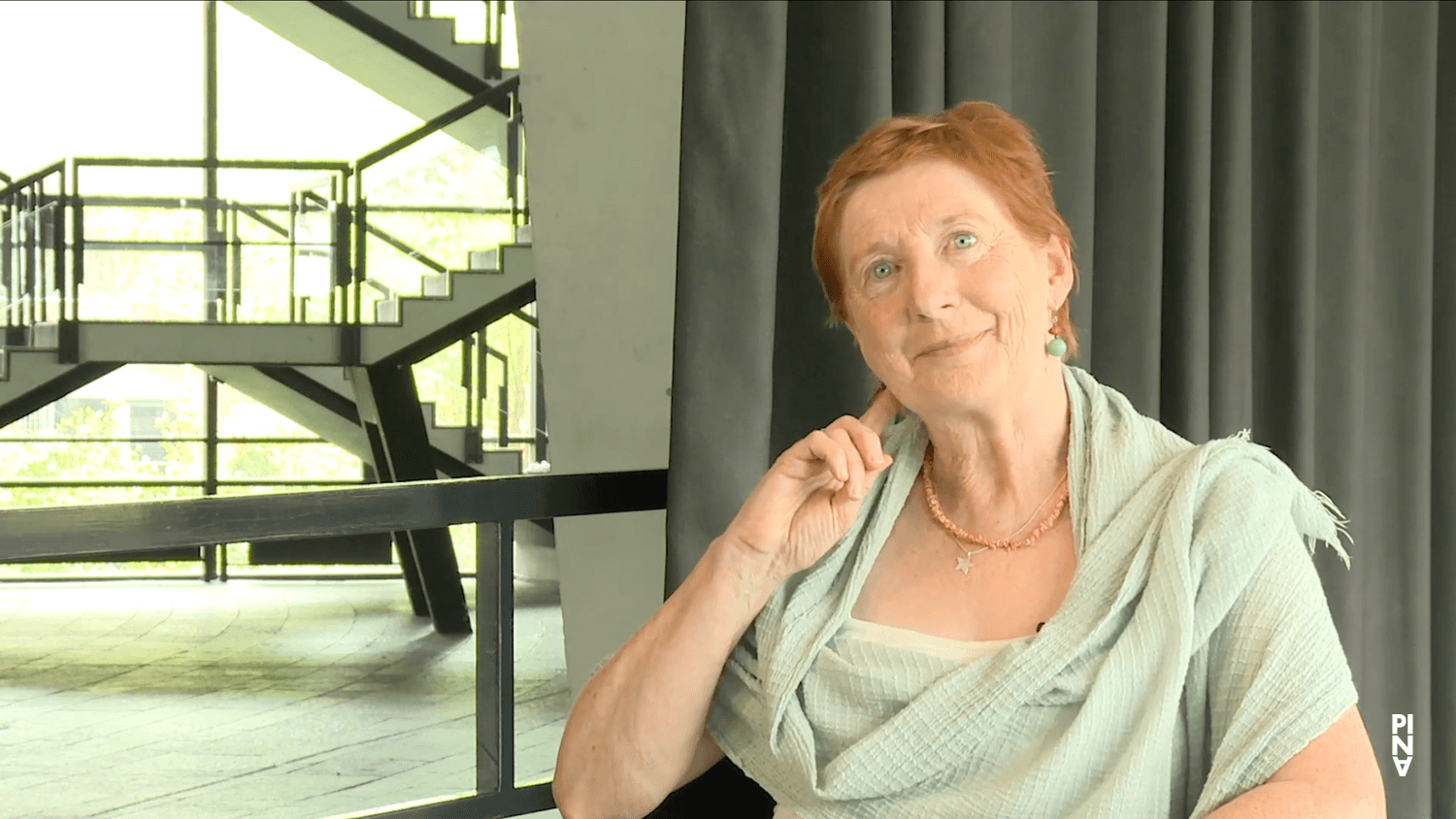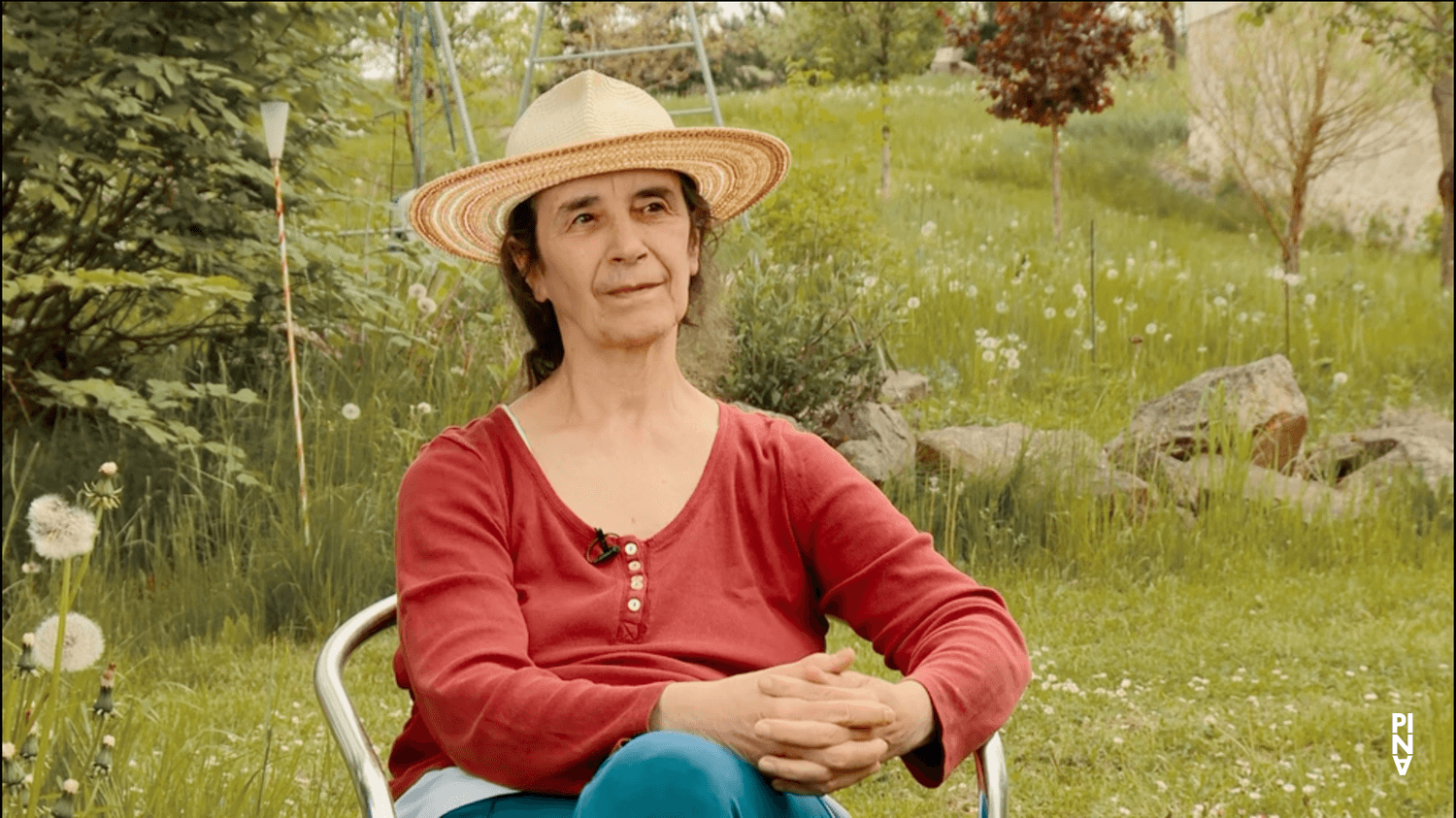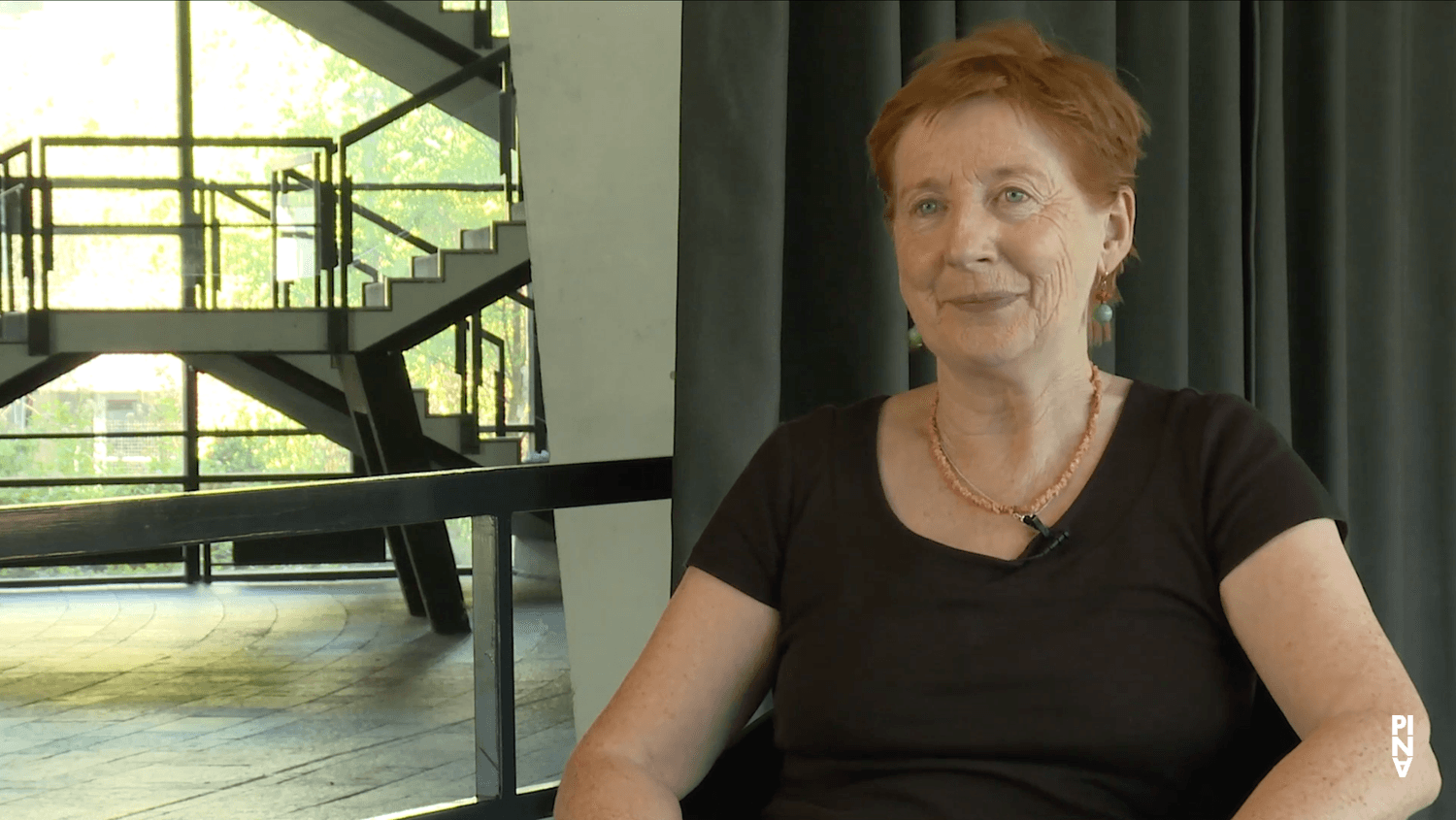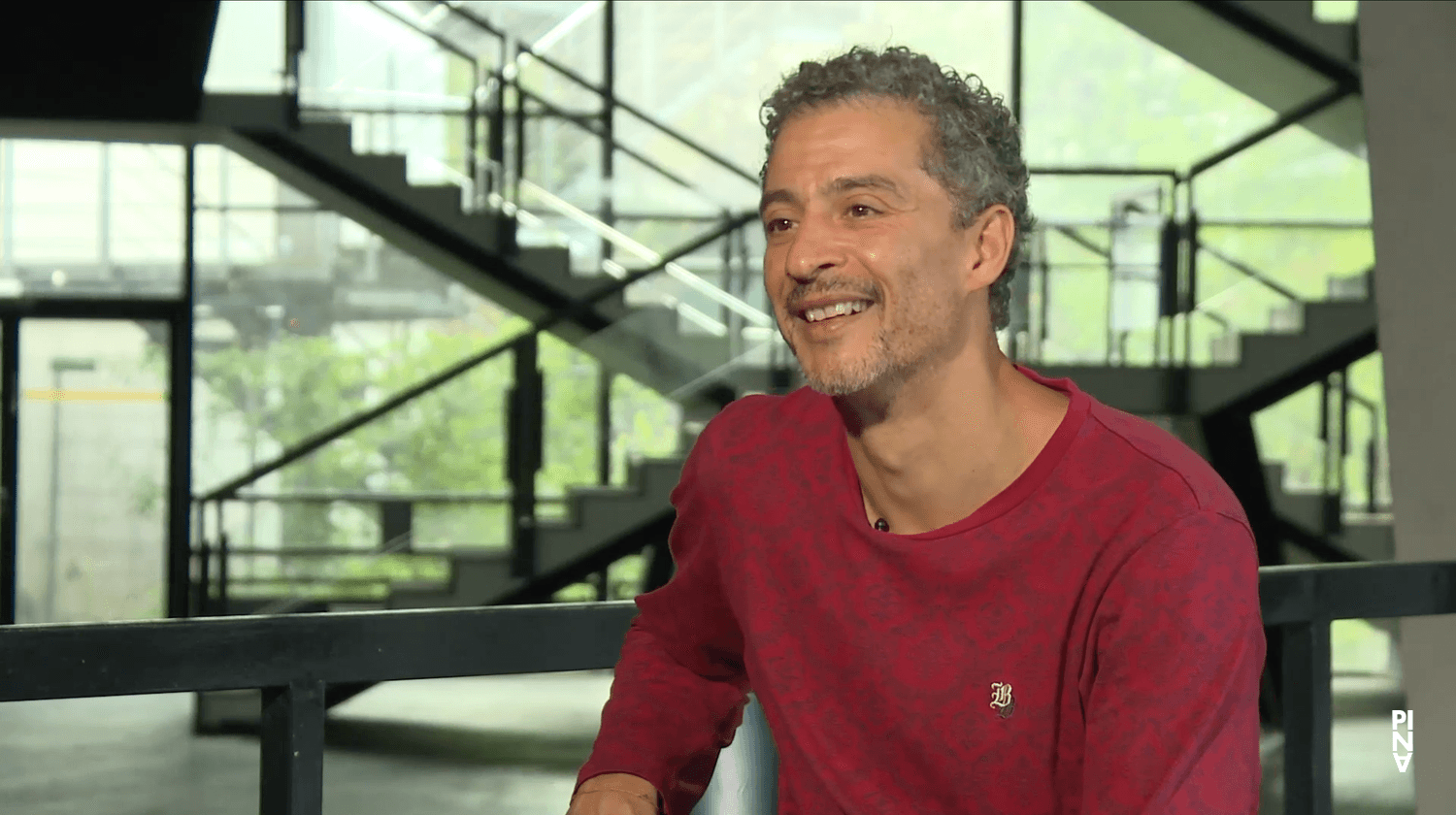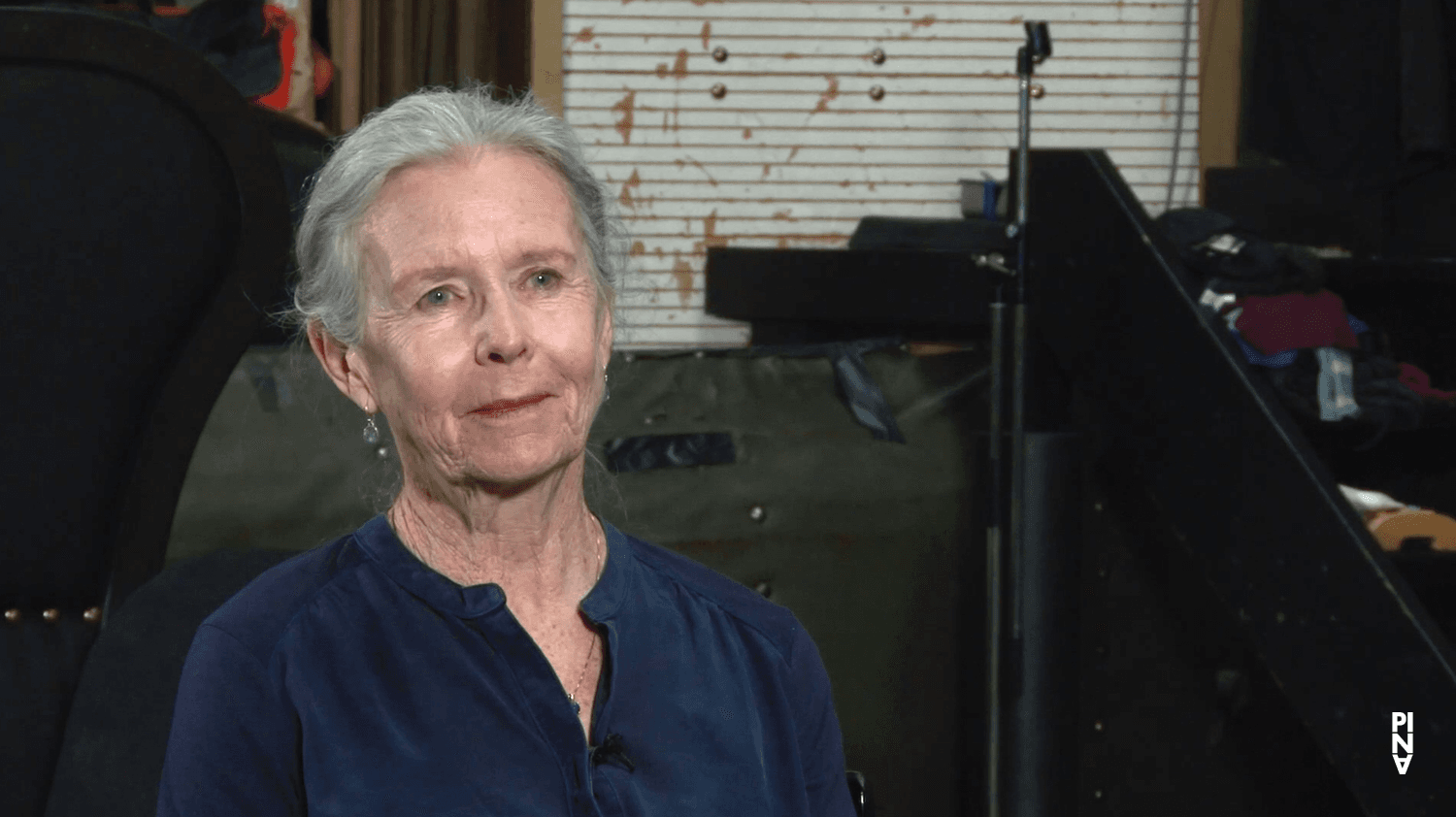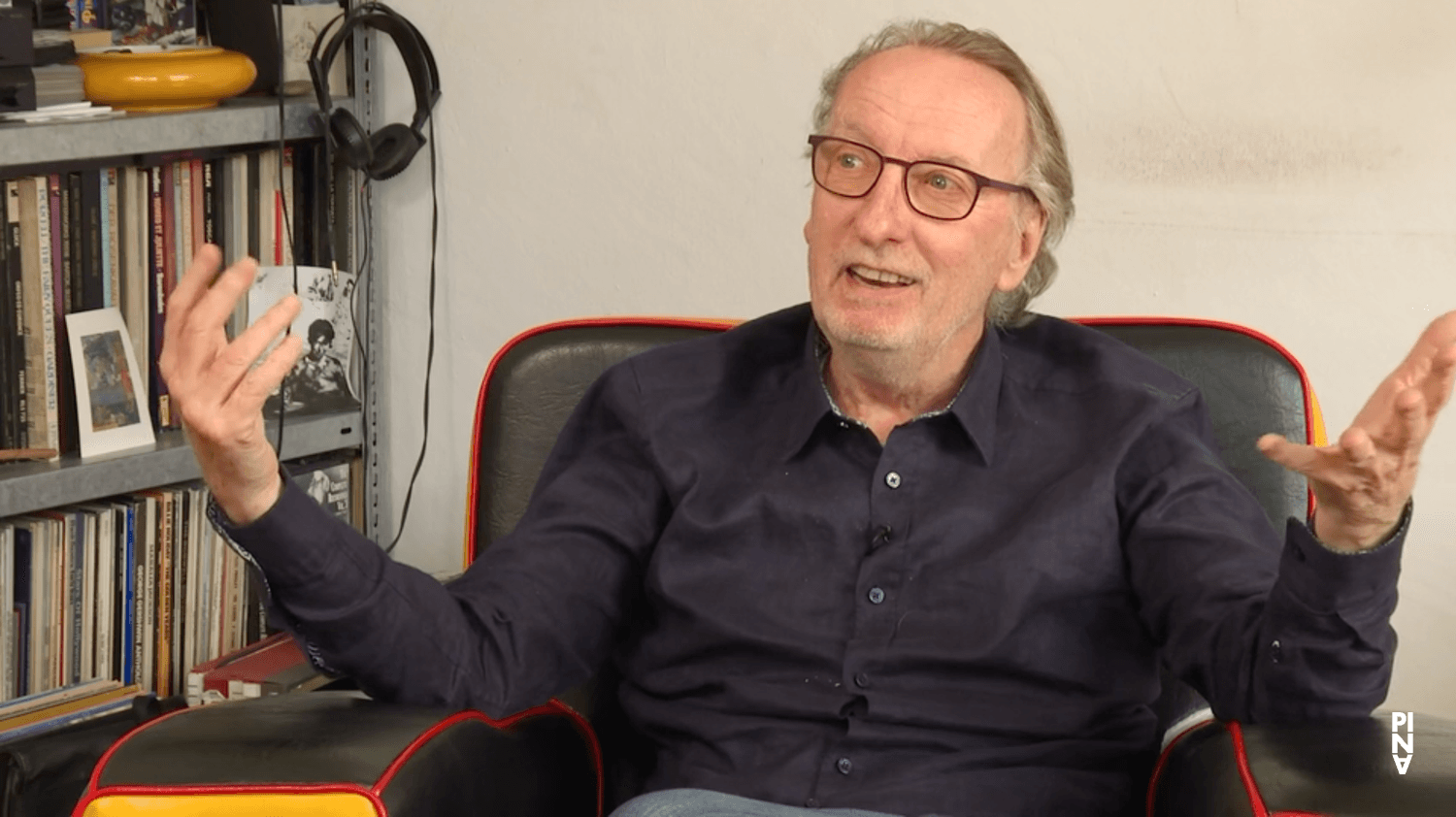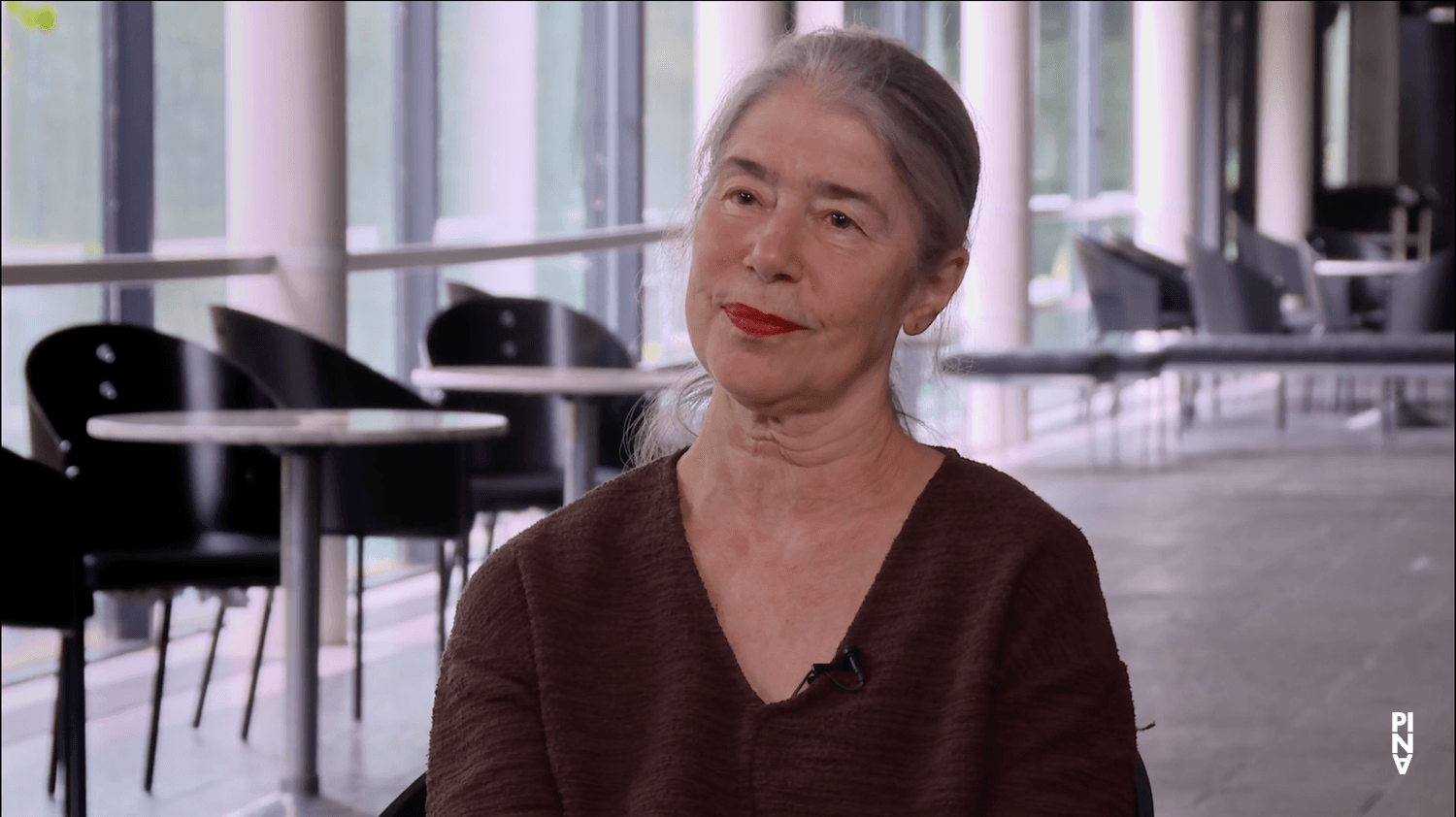Interview with Quincella Swyningan, 26/10/2022
Quincella Swyningan is a dancer who studied at the Dance Theater of Harlem and the Alvin Ailey School. She was inspired by the Balanchine Dancer Tanaquil Le Clercq and the legendary Judith Jamison. She also learned from Jean Cébron while working with the Limón Dance Company. Lutz Förster introduced her to Pina Bausch's works. She was invited her to join the Tanztheater Wuppertal in 1988. In this interview, she talks about how she learned and performed the repertoire of the company, and how she created new works with Pina Bausch. She also compares the reactions of different audiences to the works. She reflects on how the September 11 attacks in New York changed her outlook on art and life. Quincella Swyningan describes her experience in Wuppertal as fantastic and enriching.
| Interviewee | Quincella Swyningan |
| Interviewer | Ricardo Viviani |
Permalink:
https://archives.pinabausch.org/id/20221026_83_0001
Table of contents
Chapter 1.1
Dance Theater of HarlemRicardo Viviani:
Will you tell us how did you come to the art of dance? We'll open with the training or if you saw some dance. How was that?
Quincella Swyningan:
Well, I grew up in Saint Paul, Minnesota, as a teenager I was very athletic and there wasn't a lot of dance coming through Saint Paul at that time in the seventies. There were a few dance companies that did come through. I took a class with Walter Nicks. This is a very old name that will will pop up sometimes. I took a class from him and he suggested that I come to New York and study dance and train there. I finished all of my credits for high school, and I left, with the wishes of my family. I went to New York and I was fortunate enough to get a scholarship with the Dance Theater of Harlem School and also with the Alvin Ailey School. So I jumped right into the fire of things. I had a lot of good training right from the very beginning. I started very late as a dancer. That was very fortunate that I had a lot of good teachers that came through. I ended up staying with the Ailey organization and danced with their companies: they had a junior company and then the main company. As I grew and saw more works and coming from all around, like José Limón and a lot of dance companies from Europe, it was just very exciting. I was lucky to get to dance with José Limón Dance Company. At the time, Lutz Förster was doing a lot of guest work, and he was my introduction to the work of Pina Bausch. So, with the training and dancing on Broadway in New York, and dancing with many choreographers, and small companies, I was gathering all this information. I was hungry, very curious. So when the opportunity came to audition for Pina, it was just amazing.
Chapter 1.2
Touring the USRicardo Viviani:
So working for Ailey, you probably were already touring quite a bit. Have you been in Europe and Asia?
Quincella Swyningan:
Well, with the junior company we stayed in, we were domestic. Touring was a new thing for me, because coming from Minnesota, there wasn't a lot that I did outside until I started my journey as a performing artist.
Ricardo Viviani:
Did your parents see you there?
Quincella Swyningan:
It was close, but not not quite to Saint Paul, they had to travel. It was a theater just outside of Chicago.
Chapter 1.3
Palermo Palermo in NYCRicardo Viviani:
Did they come here to see you? When was the first time they saw you in the company?
Quincella Swyningan:
Actually, when I got to Pina's company, then my mother did come to the city and she saw Palermo Palermo.
Ricardo Viviani:
I would like to go one bit back and talk about what you were studying there. At the Dance Theater of Harlem School you were probably having ballet in the Balanchine tradition?
Quincella Swyningan:
It was classical ballet. Arthur Mitchell wasn't strictly in one person's style or another. He was teaching, making sure you learned the science of ballet. There were a number of teachers that came through. Tanaquil Le Clercq was the most exciting. She was so giving. I was fond her hand gestures. She was already in a wheelchair, she would just do the movement: "your legs are moving this way". She was just so elegant, so giving. That was a great experience that I have from there. I'll never forget those classes.
Quincella Swyningan:
At Ailey, it was Horton, Graham and Jazz: Matt Mattox. That was a lot, that was a whole big stew of things, along with classical ballet. So that was an experience: that school tried to give everything.
Ricardo Viviani:
They're very demanding as well. The company is a very demanding place to work, and the junior company should be the same way?
Chapter 1.5
Taking as many classes as you couldQuincella Swyningan:
Yes, it was a lot of hard work from morning to night. The life of a dancer in that era was was pretty challenging. You know, it was like with no money, like a bohemian, trying to go from day to day, and wondering what am I going to eat? Actually, spending the whole day in the school, just taking as many classes as you could. Then once we finally got into the junior company, there was that structure, and there was actually a little bit of money coming in. So that was exciting.
Quincella Swyningan:
59th Street between Third and Second Avenue.
Chapter 1.6
Judith JamisonRicardo Viviani:
Of those artists at Ailey, was there somebody that you got starstruck by, or said, I want to be that person or I am that person?
Quincella Swyningan:
There are so many. Well, of course Judith Jamison, when she was around, it was just grace, that's it. That's it. That's the spark that I need to have.
Chapter 2.1
Jean Cébron: powerful gentlenessRicardo Viviani:
We'll go back to Limón Company. There's one person that's important in the life of Pina Bausch and Lutz Förster, which is the choreographer that Lutz invited to restage his pieces. Can you talk about that little? Do you remember that? How was working with him? I'm talking about Jean Cébron.
Quincella Swyningan:
Jean Cébron: I've never met such a person that had such a gentle but powerful spirit. In his classes you could be overwhelmed by the simplicity of it, because he brought you inside of your body, like listening to the rhythm of your heart. He is almost about the breath, the breath through the body, the articulation and the arms. Everything had a part to everything. Working with him was like working with, I don't know, an angel.
Chapter 2.2
Big, joyful, mature danceRicardo Viviani:
We are the Limón Company, you were doing this works, and then you came in contact or aware of the work of Pina Bausch. When was your your first impressions or your first contacts with the company?
Quincella Swyningan:
We were invited, through Lutz, to see a rehearsal. This stage set was so amazing. That's when knew how big and joyful this dance can be. The power and the artistry, and I wanted to be part of that. It was just very mature. It was powerful. The people on stage had so much experience. I wanted to be them, I wanted to work with that, I wanted to work with people that been doing that art, and just being dynamic and full. I don't know if that makes any sense. Full in their art, like "schon da" [fully present], very present. I thought I could do that. So I was glad to have the chance.
Quincella Swyningan:
I believe it was Nelken.
Ricardo Viviani:
Was there an audition then?
Quincella Swyningan:
There was an audition. I don't think it was that year. That may have been two or another year after. I can't remember exactly, but I started in 88, the audition must have been in 87.
Quincella Swyningan:
Yes. I was invited to the audition, I had no idea what to expect. And of course, Lutz didn't say anything. He had this cat smile about him, that he often flashed, and didn't really say much about it. I thought I just go. I went, when I stood at the ballet barre and I thought, this doesn't seem like what I thought an audition from this artist would be. I'll say this: I had fun. I had fun doing the barre as well as I could. I wasn't the strongest of classical dancers. But I soon found out that wasn't that important, as important as just being me. Just being myself in the audition and I was enjoying myself. There was one point where we, I'm not sure if it was a traverse or if it was a movement in the center, but it was interesting. We were doing the movement, and I'm not sure what happened, it was like it finished or there was something odd. And I was saying something like: "Oh, that's great, can we do this again?" I started speaking, saying "can we do this again" or "that was interesting", I'm not sure exactly what I said. Oh, I wish I could. But it was totally outside of what a traditional audition would be, because in auditions you're a very stiff, everything is very structured, and you follow this and you don't speak. That's the type of audition that I've always had. I was glad to to be in there and having fun. It was a lot of giggling. I looked around, and the other people didn't seem to be having a lot of fun, but I did.
Ricardo Viviani:
Were there many people?
Quincella Swyningan:
There were quite a lot of people, especially in the first go round, then they have the first cut. After the first cut it was more relaxed. Antonio Carallo was there and he was speaking a lot to me, just trying to find out, as much information about me as he could, trying to see what kind of personality I had. That was fun.
Quincella Swyningan:
We did some movements from The Rite, from 1980, I believe. The line dances that she has put in there, one of her signature things. Yes, there were sections of repertoire that were in the audition.
Ricardo Viviani:
More than one day?
Quincella Swyningan:
That was one day. Yeah. It was a long day.
Chapter 2.6
The resultsRicardo Viviani:
What did you come out of this audition with? What did they tell you?
Quincella Swyningan:
After cutting, she called a few people over to the side, and she spoke with us. She said, I was interested in working with you, and we'll be in touch. These are words that you hear at most auditions. You're very nice and we'll be in touch. She was such a curious woman. The way she said it didn't make you feel like "I didn't make it, I'm sad". You know, it was like: "oh, okay, interesting".
Chapter 2.7
Pina Bausch: stunning, unique, understatedRicardo Viviani:
So this was your first contact with her, Pina Bausch herself. Do you remember having some kind of impression of this woman?
Quincella Swyningan:
She was just such a unique character, I mean, stunning. Stunning in her own way. She was so understated, and curious. I just thought: it would be interesting to work with her. I never worked with someone who is so quiet, and pulls you out of you, because she's so into herself. So that first impression was curious.
Chapter 3.1
Chance encouter in Reggio EmiliaRicardo Viviani:
So they left you with "We'll be in touch with you". Did that phone call come?
Quincella Swyningan:
Well, actually, it wasn't a phone call. I was teaching in Reggio Emilia and about a month after I started working there, there was this big dance company that was coming, and my students were excited to go to see this piece. I thought: "Oh, interesting. I think I know that name". They were all very excited to go and see this company. And I thought: "okay, this is nice". I didn't go to the theater with them right away. I was walking around, going to stop and have a coffee. And I ran into Dominique Mercy on the street. Dominique looked at me and he said: "We've been looking. So you're Lutz's friend, yes?" I said, yes. And he said. "We've been looking for you". I don't know. They didn't know how to get in touch with me from New York. So it was a good thing that we were all in Reggio Emilia at the same time. Otherwise, I might not have gotten that phone call, if you will. It was obviously meant to be. That's what I'm going to say. It was meant to be.
Chapter 3.2
From Italy to GermanyRicardo Viviani:
So they were looking for you. Did you get a contract, or did you go and talk to Pina.
Quincella Swyningan:
Yes, of course. We spoke, and it was like: "yes, come". I was like: "Well, I'm living here now, so I had many things". They took my things to Germany and I went to Germany.
Chapter 3.3
New ChapterRicardo Viviani:
So you were already in Europe. So it wasn't like restructuring your life in New York City to be able to go to Europe?
Quincella Swyningan:
Well, yes. I was only teaching there for I was only contracted to teach in Reggio Emilia for about six months. I was going back to New York. I did go back to New York because they had to arrange the visas and all that from New York. So that made sense. But many of my things they took to Wuppertal. So when I got to Wuppertal, I had some of my things already there. So I say my experience really started in Reggio Emilia with Pina.
Chapter 3.4
Filling in for other peopleRicardo Viviani:
So you come to Wuppertal to a very busy season.
Quincella Swyningan:
Yes, I was right away learning so many things, and a lot of different languages, different speeches, because I was filling in for other people, so I got a chance to do their parts. And of course, I had to learn some things in German, Portuguese, Japanese, because that was a big tour coming up.
Chapter 3.5
Pina's movement styleRicardo Viviani:
The movements of Pina, the choreographies that have her movements, likeSacre and Iphigenie, how was that for you?
Quincella Swyningan:
As a dancer, you respond to the choreography. I mean the movements were beautiful and powerful, and it's something that you could just ... when you saw her do it, when you saw her do these odd shapes that she could create with those long limbs ... it's difficult to answer that question in words, the emotions that I was able to put into the movement ... I mean, as a dancer, that's it. That's what I did. That's what you do. You learn the movement and the music is so powerful, and of course, the story, you know ... I have to admit, it was easy for me to pick up choreography. That was one of the things that got me through. That made me interesting to people, as I could pick it up, develop it, and be in it.
Chapter 3.6
Fast movement learnerRicardo Viviani:
You could learn fast. What about her corrections? What she helping you shape things? Were there similarities and, what were the differences? What's different about that?
Quincella Swyningan:
That's a hard question. I'm not quite sure how to answer that. Of course, in rehearsals, you get some correction. The timing is this, getting the timing correct or the spacing. And that's to be understood. That's sort of universal experience. The choreographer rarely puts you out there and doesn't do any coaching, unless you are someone who is out there with their choreography, that they are depending on you as the artist to do.
Chapter 4.1
Palermo. PalermoRicardo Viviani:
Your first new creation, premiere with Pina Bausch, which one was that? And how was that process? Italy: rehearsing, what did you bring from your ideas, and her way of working? Maybe if you can describe that what she was doing when you were there and then back.
Quincella Swyningan:
Well her process was different than anyone I had worked with in the States. For certain things she would give you a suggestion, and then you could go and work on some movements, and come back later, when we can all came back together, sort of like having a homework assignment. Coming back to kind of present your homework, if you will. She would make a suggestion, or give you an idea, ask a question. You answer the question however you feel the response should be: if it should be something spoken, something musical, you bring an instrument play it, if that's how you feel that would fulfill the request. She really wanted you to bring yourself to it, however you felt that you needed to answer that question. She allowed you to do this, with her other pieces like Iphigenie and Sacre, those choreographies were set. That's set. But with something like with Madrid and Palermo there was a lot of give and take. She would challenge you with an idea, or challenge you with a piece of music, challenge you with a story. She would give you something to read and say: "Well, give me something, your response to this"; or show your photograph, and say give me a response to this, something that really made open yourself up to whatever kind of experience. Like looking at this photograph, it's like if you're struck try to bring that into a movement, or an idea, or just a feeling, or just show that feeling to the audience. Yes, she really allowed you to be you within the context of whatever incredible environment that was being created physically.
Chapter 4.2
Palpable trustRicardo Viviani:
Did you feel that trust? Did she create an environment for you that you could feel "Okay, this is safe"?
Quincella Swyningan:
I think everyone had their own experience. But you you were in a safe place. You could let just let your feelings take over. She would offer something and it was a wonderful feeling to just be trusted, to bring every bit of yourself to what that moment meant for you. Whatever it was: if was just a movement, a thought, a pose. Yes. I think she was trusting us to bring your spirit to her spirit and blend and make something incredible.
Chapter 4.3
"Come inside yourself"Ricardo Viviani:
Did you learn things about yourself or did you learn things about the others? Was that enrichment in your experience?
Quincella Swyningan:
It was like a family. You learn different things about each other. You get to know the things that this person likes to do, and this person would like to do. In the creative environment, there was no hierarchy, not like the corps de ballet and the principals. You were there working, you were creating, enjoying it, giving birth to this incredible experience. Some of the things that you offered were really horrible. Coming from America, a lot of things were just big and out there. The first thing that she did for me was that she wanted me to pull in. "Come inside yourself, you don't have to be outside. Show us what's inside. Let us feel it. Let's fill with your feeling, just very subtle, small, small movements." That's where the power was coming from. Being small, a bit like what you learned from Jean Cébron. "What's inside your heart? Bring that forth, what's in your little finger. How is that finger doing? What's that elbow doing?" So, she helped me to enjoy being, I don't want to say compact, intimate with my performing, intimate with the audience. That didn't mean: looking at them, I'd see you, I see you see me, it wasn't like that. On stage the movement it's from me, I give it to you, and you like it or not.
Chapter 4.4
Sugar in the lipsRicardo Viviani:
Sugar in the lips and sweet kisses: was that an idea from you. How did that come by?
Quincella Swyningan:
Sugar in the lips. I like to wear lipstick. Would wear lipstick a lot. I would wear jewelry. I'm not sure if that is something that she wanted me to do to replace the lipstick you're putting on. Putting on your lipstick to give someone a sweet kiss. Oh. You know, those things were just so private and just so personal that when it happened, it just happened. It was. It was just that moment. Now, I guess ... Sweet kiss.
Quincella Swyningan:
That's why we love it. That's why we love it. Theater, live theater, there's nothing like it. Nothing else like it.
Chapter 4.6
MadridRicardo Viviani:
The next piece has, even today, the title Tanzabend II. Do you have remembrances of that one work?
Quincella Swyningan:
Yes, I wish I could see it again. So much of her work is just so much a part of me, it's hard to say, that I feel from that piece and I feel from that other piece.
Chapter 4.7
The universe of the workRicardo Viviani:
So does that mean that for you, your time in Wuppertal became this journey within this universe of her work?
Quincella Swyningan:
Well, yes, that's why I was there. To enjoy, to learn and to work, to be part of this. To bring my artistry there and have that shaped, and let it grow within what she needed, and what the pieces needed. So I guess you could say, yes, I was in the universe.
Chapter 4.8
The fall of the wallRicardo Viviani:
This was a very interesting point in history especially for Germany, with the fall of the wall and Germany being drawn into the reunification process. That's when I moved to Germany. And at that point, we knew that the wall fell and that meant a lot. We didn't know, what it would mean as far as life, and as far as relationships to the art in that place. How were you aware of this outside world?
Quincella Swyningan:
Of course, I knew what was going on and I wasn't in a bubble, but the feeling of me being in a new country, and that was separate and now coming back together and they're going into political turmoil. I didn't really know what to think. You lived through it. Whatever changes, you followed the changes. For me few things, like going through the eastern part, was kind of being in a movie, where you had to show your passport and state your purpose. Everything was very serious, it was a very serious moment. I have to say.
Chapter 4.9
Trauerspiel Perfect title for my experienceRicardo Viviani:
And the last production that you did Schiff was recently revived. Oh, no, there's Schiff and then there's Trauerspiel. Do you have memories of Trauerspiel and Vienna?
Quincella Swyningan:
That was a very rocky time. A lot of changes with me, my life, my emotions, my decisions. I was very sad. There was a lot of sadness around, I mean, this is me. Every dancer was in their own particular place at the time. But for me it was very powerful, and a lot of changes, a lot of adjustments, a lot of introspection going on. It brought out a lot of powerful things that were inside of me, and that I was in a safe place and they could come out. And I could be sad, and my heart could be raw, and I could feel the feelings that was having. And they were not pretty all the time. I mean, that's the perfect title for it. Perfect. This was a tough time.
Chapter 4.10
Kontakthof Film NoirRicardo Viviani:
The environment of this Ballroom in Kontakthof: is that something that you can recall from your teenager years?
Quincella Swyningan:
Absolutely not. This was not a part of my life. Many of these pieces have really no part in my experience and life. For me as a very athletic and purposeful dancer Revelations [Alvin Ailey 1960] was powerful, but Kontakthof was a feeling of being in film noir: the costume, the environment, the music. It was that specific era where I never had the experience. Where you go to a dance hall to dance, to meet people, to socialize. A lot of these situations, that came up in many of her pieces and in the repertoire that I was able to jump into, I had no experience with it. I mean Walzer with these big dresses, and formal dancing, dancing together - social dancing was a very different animal for me. Nothing in my experience so far. So, it was acting, I was able to get into the work.
Quincella Swyningan:
Oh, the costumes are just. I mean, amazing. Amazing.
Chapter 5.2
Gorgeous and uncomfortableRicardo Viviani:
How did it make you feel about it: womanhood and being a woman?
Quincella Swyningan:
Oh, the dresses they're gorgeous. They were tight and uncomfortable, and the zippers, you still had to have the freedom to move certain things. It was fun dressing up. I like to dress up, but these people, they were never really part of my upbringing. I never really wore such dresses.
Ricardo Viviani:
But when they think about a person like Judith Jamison, this lady is something that I connect with long dresses.
Quincella Swyningan:
I don't know. My early environmental experiences were more, I don't want to say immature, but more childlike-fantasy from the States. Then, I got into doing the works of Pina, where she had these feelings from her childhood, where women were dressing like this, going to meet people, dancing. I would say the maturity of the theatrical presentation, was far different from what I experienced in a lot of my dancing, early in the States.
Chapter 6.1
Complex nuanced organized chaosRicardo Viviani:
I would think that that would give the license to play.
Quincella Swyningan:
Of course. That's what theater is, and that's the license to play. You're acting, you get to dress up in a tight dress that you never would imagine yourself wearing. You still get to run around, and to have friends play jokes on you, move the chair out of the way, tease you, and let you fall on your bum. Have these this fun experiences, evoke emotions that sometimes are coming out of nowhere. Suddenly the whole mood has changed, this is not funny, it' not a joke. Then something else playful can come along. It's is what theater does it, it's what Pina does so well with her organized chaos, that she brings. You're inside of it, and it's not until you have a chance to see the piece, that you really can see how incredibly complicated and complex and full her work is. When you're outside of it, when you're outside of any work that you've done, the perspective changes so much. I mean, you have a chance to see and experience what the audience is seeing. They're seeing night into day, caves, people having auctions in a grave, you see it and it's so different, because you know what you were doing in that. This is what you were doing, you were feeling this, you were going there, you were covering this area, you were creating this effect. When you are on the outside and you get to see it, sometimes you think: that has a different feeling from what I thought it might for the audience. Then, of course, each audience is different, however they are going to experience it. Whether they're going to be seeing just the surface of it, or are they actually going to be able to let themselves relax, open up, come in so that they can really, really see it and experience. That is also the difference between a European audience and the American audience. That's kind of tacky to say, but it's interesting: for Pina's audiences it's a learning curve, because there's so many silences and nuances. You have to wait for the silence, you have to let it happen. You can't just jump up all excited, you will miss the very texture of that last vital hag that she has. You will miss hearing the footsteps. You miss hearing the slide. You will miss hearing something. You will miss seeing something in your enthusiasm to the "oh, my gosh, I'm so moved. I love it. I love it." American audiences had to be trained to enjoy her pieces.
Chapter 6.2
Check in with yourselfRicardo Viviani:
So we are at the last season that you did. There was Trauerspiel. Did you leave at the end of the season? When did you realize that it was time for you to move on?
Quincella Swyningan:
That's another one of those funny questions because as an artist you want to perform, and your life is performing. Certain things happen, maybe it's not feeling so good, maybe you are burnt out. You need a break. There's a lot of stuff that happens in everybody's life. No matter what sector you're in. Whatever you do, and you're giving your all, and it's just draining you. You love it, but it takes everything, because you give everything. Sometimes you need to take a break, or to take an official pause, go away and come back to it. Sometimes in the theater, or in dance is not always possible. In America, if you take a break, it's okay, and this other dancer is right there to take your spot. It goes on, if you want to move on as a dancer, you go, but don't think that you might come back. There have been situations, like everything, you need to check in with yourself.
Chapter 7.1
Théâtre équestre ZingaroRicardo Viviani:
What did you do next? And how did you come there?
Quincella Swyningan:
Well, Zingaro - Bartabas is the director of this equestrian theater where the horses are the stars and the musicians and dancers and actors are the decorations for them. He was apparently thinking of a piece to do. He had an idea for a work, and he and Pina would talk often because he loved her work, and she was fascinated by the horses. I don't know how their relationship came about. But she mentioned to me that he was looking for someone to be a part of this next work. She asked me if I was interested, and I said sure, why not? That's quite a change from what we've been doing. I went to Aubervilliers where the compound is, just outside of Paris. Met them, saw their performances in New York also, before I came to be with the company. It was it was an interesting idea, another challenge, another thing to put myself, to make it a part of me. That was quite interesting. I've never worked with horses, and they're very pretty, and they're very big. I was flattered that he was considering me to do this. Sure, let's go.
Ricardo Viviani:
How long?
Quincella Swyningan:
The contract was three years. You know, so to create the piece and tour it.
Quincella Swyningan:
I stayed in Paris for a while to do some teaching. Paris was a whole another life. I was lucky to have the experience.
Chapter 8.1
September 11Ricardo Viviani:
Just to wrap up, how did this experience inform what you were to do subsequently?
Quincella Swyningan:
When I was with Zingaro there were some teaching opportunities, doing workshops here and there and that was that was interesting. It's a small community there, and there wasn't a lot of choreographic opportunities that I sought it out. That wasn't so interesting to me. I learned that I wasn't so interested in going into the structure of pedagogy, and getting students from level and this level. I enjoyed teaching. I enjoyed coaching, but I knew I was not interested in university teaching. It was another learning curve. So, when I did finally come back to the States, I was really glad to have a total break to just come back and figure out who I was. I came back at one of the worst times in history. Absolutely, the worst time ever. When I got back to the States, it was two weeks before September 11 and everything was just upside down. Everything was just upside down. Coming from Paris and being a free and full dancer, performer, coming back to really madness. What is this world? What is this? It's just so far from anything, right. That was a difficult couple of years: coming back and adjusting, not only to having not come into a dance situation, which is something I felt safe doing, because it was who I am. But coming back to a world where nothing was right. Nothing was right. It was frightening. It was dark, a couple of years where it was just very, very dark. So, I studied a lot of computers. So I sort of separated myself from humanity, and started doing software, and learning working with computers. Let me just take my self away from these people who are not human. There's no humanity here. So I worked with machines for a while.
Chapter 8.2
Lots of good sharingRicardo Viviani:
Did you keep in touch when the company came to NY, did you go to see them?
Quincella Swyningan:
Sure. Julie Stanzak, Julie Shanahan, the whole group that I worked with of the people who came, not everybody came always, depended on pieces that they were doing. So that was great. Reunions like that are brief, of course, because they're working and I'm working. It was a lot of good sharing, to bring up the good feelings in all.
Chapter 9.1
A fantastic journey. Rich!Ricardo Viviani:
To wrap up, that one question: What is Tanztheater? Either for you personally in your life, or within the context of dance as you lived it, or whichever way you want to talk about that.
Quincella Swyningan:
You and your funny questions. What is Tanztheater? Another life. A fantastic journey. Learning, loving, gaining, losing. Opening my heart. Having my heart broken. Building friendships that even though there's vast differences, distance. It's my relationship with each person, it is special. And even though you don't call each other all the time, you don't see each other. You get to see, pictures of the babies, to see how people are evolving, how they're growing, and rich. Rich.
Suggested
Legal notice
All contents of this website are protected by copyright. Any use without the prior written consent of the respective copyright holder is not permitted and may be subject to legal prosecution. Please use our contact form for usage requests.
If, despite extensive research, a copyright holder of the source material used here has not been identified and permission for publication has not been requested, please inform us in writing.
